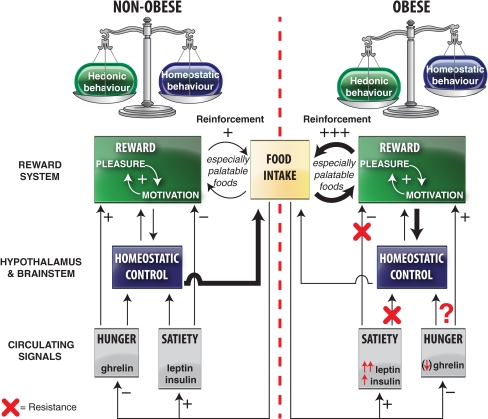Fig. 1.
Schematic illustration of the interactions of between homeostatic/metabolic and hedonic control of food intake in normal weight and obese individuals. Palatable foods reinforce their consumption by increasing both the motivational and hedonic components of the reward process. Whereas homeostatic signals are able to put a brake on food reinforcement in normal weight individuals, this does not appear to be the case for the obese. Moreover, increased food intake in obesity may reflect an allostatic shift in the set-point for food reward, characterized by either an increased hedonic requirement (the reward hyperfunction theory) or an increased motivation to compensate for a hedonic deficit (the reward hypofunction theory). By analogy with chemical drug addiction, problematic over-eating may commence with an increased hedonic requirement but with increased exposure, the hedonic/rewarding value of the food decreases, resulting in an increased motivation for food (ie eating in the absence of pleasure in the ‘food addicted’ state). Unfortunately obesity- associated leptin and insulin resistance likely play an important role to desynchronize these appetitive brain mechanisms. Recent studies have identified the central ghrelin signalling system as having an important role for increasing food reward. Given that obese individuals appear to remain ghrelin sensitive, future therapies for problematic overeating could include ghrelin antagonists

